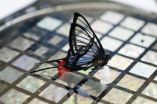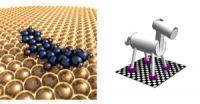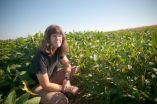(Press-News.org) Though it was once believed that all asteroids are giant pieces of solid rock, later hypotheses have it that some are actually a collection of small gravel-sized rocks, held together by gravity. If one of these "rubble piles" spins fast enough, it's speculated that pieces could separate from it through centrifugal force and form a second collection ― in effect, a second asteroid.
Now researchers at Tel Aviv University, in collaboration with an international group of scientists, have proved the existence of these theoretical "separated asteroid" pairs.
Ph.D. student David Polishook of Tel Aviv University's Department of Geophysics and Planetary Sciences and his supervisor Dr. Noah Brosch of the university's School of Physics and Astronomy say the research has not only verified a theory, but could have greater implications if an asteroid passes close to earth. Instead of a solid mountain colliding with earth's surface, says Dr. Brosch, the planet would be pelted with the innumerable pebbles and rocks that comprise it, like a shotgun blast instead of a single cannonball. This knowledge could guide the defensive tactics to be taken if an asteroid were on track to collide with the Earth.
A large part of the research for the study, recently published in the journal Nature, was done at Tel Aviv University's Wise Observatory, located deep in the Negev Desert ― the first and only modern astronomical observatory in the Middle East.
Spinning out in space
According to Dr. Brosch, separated asteroids are composed of small pebbles glued together by gravitational attraction. Their paths are affected by the gravitational pull of major planets, but the radiation of the sun, he says, can also have an immense impact. Once the sun's light is absorbed by the asteroid, rotation speeds up. When it reaches a certain speed, a piece will break off to form a separate asteroid.
The phenomenon can be compared to a figure skater on the ice. "The faster they spin, the harder it is for them to keep their arms close to their bodies," explains Dr. Brosch.
As a result, asteroid pairs are formed, characterized by the trajectory of their rotation around the sun. Though they may be millions of miles apart, the two asteroids share the same orbit. Dr. Brosch says this demonstrates that they come from the same original asteroid source.
Looking into the light
During the course of the study, Polishook and an international group of astronomers studied 35 asteroid pairs. Traditionally, measuring bodies in the solar system involves studying photographic images. But the small size and extreme distance of the asteroids forced researchers to measure these pairs in an innovative way.
Instead, researchers measured the light reflected from each member of the asteroid pairs. The results proved that in each asteroid pair, one body was formed from the other. The smaller asteroid, he explains, was always less than forty percent of the size of the bigger asteroid. These findings fit precisely into a theory developed at the University of Colorado at Boulder, which concluded that no more than forty percent of the original asteroid can split off.
With this study, says Dr. Brosch, researchers have been able to prove the connection between two separate spinning asteroids and demonstrate the existence of asteroids that exist in paired relationships.
INFORMATION:
American Friends of Tel Aviv University (www.aftau.org) supports Israel's leading and most comprehensive and most sought-after center of higher learning. Ranked #114 in the world in independent rankings, TAU's innovations and discoveries are cited more often by the global scientific community than all but 20 other universities worldwide.
Internationally recognized for the scope and groundbreaking nature of its research programs, Tel Aviv University consistently produces work with profound implications for the future.
Avoiding an asteroid collision
Tel Aviv University researchers reveal a new dimension in the study of asteroid pairs
2010-09-13
ELSE PRESS RELEASES FROM THIS DATE:
Male maturity shaped by early nutrition
2010-09-13
EVANSTON, Ill. --- It seems the old nature versus nurture debate can't be won. But a new Northwestern University study of men in the Philippines makes a strong case for nurture's role in male to female differences -- suggesting that rapid weight gain in the first six months of life predicts earlier puberty for boys.
Males who experienced rapid growth as babies -- an indication that they were not nutritionally stressed -- also were taller, had more muscle and were stronger, and had higher testosterone levels as young adults. They had sex for the first time at a younger ...
Manatee subspecies genetically confirmed, but diversity challenge looms
2010-09-13
Gainesville, FL. -- The first genetic study to compare nuclear DNA of endangered Antillean manatees in Belize with Florida manatees confirmed their designation as separate subspecies. Belize's manatees, however, were found to have extremely low genetic diversity, raising questions about their long-term genetic viability.
The Central American country of Belize hosts the largest known breeding population of Antillean manatees and is touted by biologists for its potential to repopulate other parts of Central America where manatees are severely reduced, rare or absent.
...
Information patients use to pick physicians not always good predictor of quality, study finds
2010-09-13
When looking for a new physician, patients are often encouraged to select those who are board certified or who have not made payments on malpractice claims. Yet these characteristics are not always a good predictor of which physicians will provide the highest quality medical care, according to a new study from the RAND Corporation, a nonprofit research organization, and the University of Pittsburgh School of Medicine.
"We found that the types of information widely available to patients for choosing a physician do not predict whether that physician will deliver evidence-based ...
Wildflower 'armors' itself against disease
2010-09-13
An unusual wildflower that accumulates metals in its leaves has been found to use them as a kind of 'armor' against bacterial infection. Scientists from Oxford University have shown that when Alpine pennycress (Thlaspi caerulescens) plants accumulate metals in their leaves, they become resistant to attack by the bacterium Pseudomonas syringae pv. maculicola. They report their findings September 9 in the open-access journal PLoS Pathogens.
Thlaspi, a small plant in the mustard family that grows on metal-rich soils scattered around Britain and Europe, such as the sites ...
New artificial skin could make prosthetic limbs and robots more sensitive
2010-09-13
VIDEO:
Artificial skin for people and robots could be a reality using the ultra-sensitive sensors developed by Zhenan Bao, associate professor of chemical engineering at Stanford University, and her team. The...
Click here for more information.
The light, tickling tread of a pesky fly landing on your face may strike most of us as one of the most aggravating of life's small annoyances. But for scientists working to develop pressure sensors for artificial skin for use on ...
Would a molecular horse trot, pace or glide across a surface?
2010-09-13
RIVERSIDE, Calif. – Molecular machines can be found everywhere in nature, for example, transporting proteins through cells and aiding metabolism. To develop artificial molecular machines, scientists need to understand the rules that govern mechanics at the molecular or nanometer scale (a nanometer is a billionth of a meter).
To address this challenge, a research team at the University of California, Riverside studied a class of molecular machines that 'walk' across a flat metal surface. They considered both bipedal machines that walk on two 'legs' and quadrupedal ones ...
New pathway identified in Parkinson's through brain imaging
2010-09-13
(NEW YORK, NY, September 13, 2010) – A new study led by researchers at Columbia University Medical Center has identified a novel molecular pathway underlying Parkinson's disease and points to existing drugs which may be able to slow progression of the disease.
The pathway involved proteins – known as polyamines – that were found to be responsible for the increase in build-up of other toxic proteins in neurons, which causes the neurons to malfunction and, eventually, die. Though high levels of polyamines have been found previously in patients with Parkinson's, the new ...
Wives as the new breadwinners
2010-09-13
Durham, NH—September 13, 2010— During the recent recession in the United States, many industries suffered significant layoffs, leaving individuals and families to revise their spending and rethink income opportunities. Many wives are increasingly becoming primary breadwinners or entering the labor market. A new article in Family Relations tests "the added worker" theory, which suggests wives who are not working may seek work as a substitute for husband's labor if he becomes unemployed, and finds that during a time of economic downturn wives are more likely to enter the ...
Making cookies that are good for your heart
2010-09-13
VIDEO:
Years of research has proven that saturated and trans fats clog arteries, make it tough for the heart to pump and are not valuable components of any diet. Unfortunately, they...
Click here for more information.
COLUMBIA, Mo. ¬— Years of research has proven that saturated and trans fats clog arteries, make it tough for the heart to pump and are not valuable components of any diet. Unfortunately, they are contained in many foods. Now, a University of Missouri research ...
Obama administration responds to call to action from Concordia researchers
2010-09-13
Montreal / September 13, 2010 – September 21, 2010 marks the one year anniversary of the release of a landmark document produced by researchers at Concordia University. Mobilizing The Will to Intervene (W2I) offers governments practical steps to prevent future genocides and mass atrocities. Produced by researchers with the Montreal Institute for Genocide and Human Rights Studies (MIGS) based at Concordia, the document was presented to the governments of Canada and The United States of America. It has already yielded concrete results.
Under President Barack Obama's leadership, ...
LAST 30 PRESS RELEASES:
Discovery on how aggressive breast cancer controls protein production
A simple blood test can predict Crohn’s disease years before symptoms appear
FAU study reveals social, family and health factors behind teen bullying
New alliance trial seeks to reduce delays in gastrointestinal cancer treatment
Discovery of a new superfluid phase in non-Hermitian quantum systems
Codes in the cilia: New study maps how Cilk1 and Hedgehog levels sculpt tooth architecture
Chonnam National University researchers develop novel virtual sensor grid method for low-cost, yet robust, infrastructure monitoring
Expanded school-based program linked to lower youth tobacco use rates in California
TV depictions of Hands-Only CPR are often misleading
What TV gets wrong about CPR—and why it matters for saving lives
New study: How weight loss benefits the health of your fat tissue
Astronomers surprised by mysterious shock wave around dead star
‘Death by a thousand cuts’: Young galaxy ran out of fuel as black hole choked off supplies
Glow with the flow: Implanted 'living skin' lights up to signal health changes
Compressed data technique enables pangenomics at scale
How brain waves shape our sense of self
Whole-genome sequencing may optimize PARP inhibitor use
Like alcohol units, but for cannabis – experts define safer limits
DNA testing of colorectal polyps improves insight into hereditary risks
Researchers uncover axonal protein synthesis defect in ALS
Why are men more likely to develop multiple myeloma than women?
Smartphone-based interventions show promise for reducing alcohol and cannabis use: New research
How do health care professionals determine eligibility for MAiD?
Microplastics detected in rural woodland
JULAC and Taylor & Francis sign open access agreement to boost the impact of Hong Kong research
Protecting older male athletes’ heart health
KAIST proposes AI-driven strategy to solve long-standing mystery of gene function
Eye for trouble: Automated counting for chromosome issues under the microscope
The vast majority of US rivers lack any protections from human activities, new research finds
Ultrasound-responsive in situ antigen "nanocatchers" open a new paradigm for personalized tumor immunotherapy
[Press-News.org] Avoiding an asteroid collisionTel Aviv University researchers reveal a new dimension in the study of asteroid pairs



